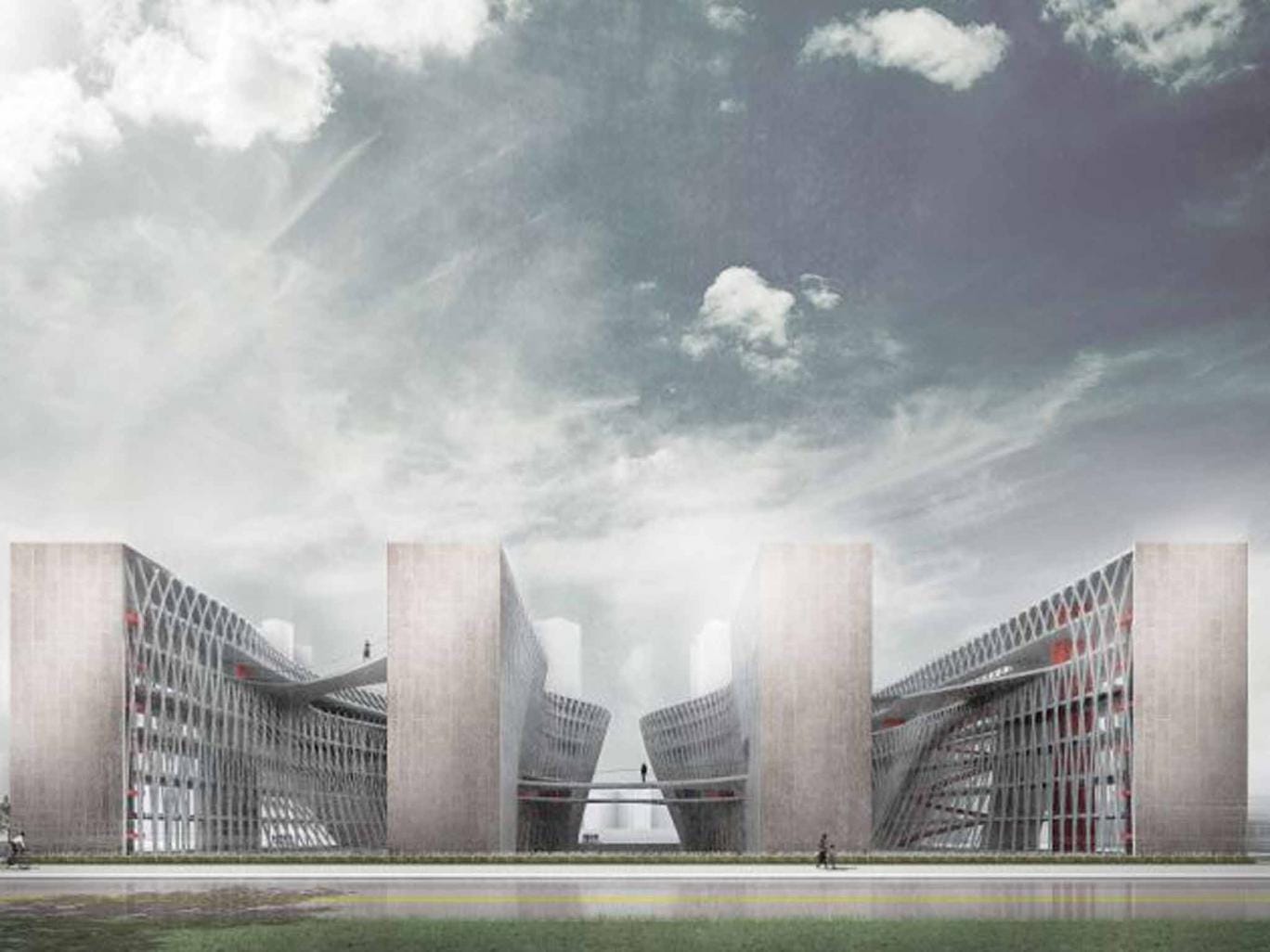
“Norman Stanley Fletcher, you have pleaded guilty to the charges brought by this court…” The opening words of classic sitcom Porridge, of course, as Ronnie Barker's character “Fletch” enters the classic British nick: a gothic arch over a portcullis-like door, leading into a dour labyrinth of bricks and bars.
“These are the archetypal prisons of the public imagination,” says Chris Costelloe, director of the Victorian Society. “We always think of high masonry walls, big gates and the term 'Dickensian'. They're grim.” Deliberately so, one might argue.
Yet several of these classic old prisons now find themselves in prime urban sites, and of course, they can't be left alone. Chancellor George Osborne has announced that he will close several, including the women's prison Holloway, Pentonville, Wandsworth and the legendary Wormwood Scrubs – itself star of appearances in The Italian Job, Minder and Steptoe and Son, the very name conjuring carbolic soap and caper movies.
They'll be developed, mostly as housing, and nine new prisons will be built on brownfield sites outside urban areas.
Osborne's policy move came after justice secretary Michael Gove tagged these gloomy old nicks “ageing and ineffective”, replete with “bullying, drug-dealing and violence”, and the idea draws from Gove's think-tank Policy Exchange's 2013 report Future Prisons, which proposed a programme of high-tech “hub” prisons deploying “cutting-edge architecture”, each housing up to 3,000 inmates in “campus-style” units around centralised services. They'd have “resettlement” aspects built in, wider community and share sites [eg, courts] with other parts of the criminal justice system,“ said the report, and the Government's heritage body Historic England isn't, says a spokeswoman, ”opposed to the sale and re-use of historic prison buildings, provided that any new development is done sensitively to the distinctive character and history of the buildings“.
On the face of it, it's hard to argue against the decommissioning of Victorian prisons, punitive edifices whose massive walls express the opprobrium of the state, and seem to refer to the castles and dungeons of incarceration's deep history. Their most common design – cells arranged in galleries around a central atrium – does a good job. “They're often very good at sight lines and security,” says Juliet Lyon of the Prison Reform Trust (PRT). But they're too much at the punitive end of the spectrum and don't speak of Lyon's two pillars of “redemption and rehabilitation”. “Some still have 'slopping out',” says Lyon. “They're a health and safety nightmare where people share cells with open toilets, and they incubate resentment.” Harsh brick walls and stress-inducing slamming doors – those steel-on-brick clangs we all know from prison dramas – don't help.
The UK has historically been a prison-design leader and gave the world one of the most famous designs, in the Panopticon, created by British social theorist Jeremy Bentham in the late 18th century and made famous to a generation of students by the French philosopher Michel Foucault, who saw them as a metaphor of a brutalised surveillance society. This design enabled a smaller number of guards to watch the same amount of prisoners from a central point, cutting down on costs and supposedly leading to self-restraint by prisoners, who would act differently in the knowledge that they were being watched – an early portent of the CCTV era. The 19th-century prisons drew from that well.
So do the UK's new prisons follow this tradition? Not really. Our new jails are mostly brick-faced warehouses with high fences in low-value areas. Two noteworthy prisons are exemplars: Oakwood in the Midlands, designed by Pick Everard in a “modern custodial aesthetic”, which has naturally lit rooms and double-height association spaces, and as-yet unbuilt Wrexham, by the Aedas group, mooted to hold 2,100, which says it will be providing “activity associated with rehabilitation” and claims to reflect “local distinctiveness and character” in 14 buildings, including a visitor support building, workshops and an energy centre.
But Yvonne Jewkes, professor of criminology at the University of Leicester, thinks that despite such humanising appurtenances, these edifices are more akin to the “Amazon warehouse” typology, hardly “cutting-edge architecture”, more a container model imported from the US: bland and technocratic, with a smell of fear and an assembly-line ethos. In a recent paper, Designing Punishment: Balancing security, creativity and humanity in contemporary correctional systems, Jewkes wrote that “prisons send a clear message about punishment from the 'carefully scripted' construction of their façades” and that the new “bland, corporate-looking” prisons have no architect engagement with their “clients” or if you prefer, end users. It's not about them. Maybe the nine prisons-to-be will be akin to Jewkes' desire for an “architecture of hope”. But she is not optimistic, and nor is architect Will Alsop of aLL Design. Ten years ago, Alsop made a project with organisation Rideout (Creative Arts for Rehabilitation), a company that promotes the arts within the penal system, and found all manner of spirit-crushing detail: beds just 6ft long, lavatories in cells two feet away from the bed. “They bang up prisoners in these miserable places,” he says. “No wonder they're universities of crime.” Alsop recommended giving prisoners more agency: their own keys to cells, meaningful jobs, better education and mixed age groups – even allowing prisoners to paint their cells so as to achieve “a sense of place” – and his HMP Paterson concept (named after pre-war prison reformer, Alexander Paterson) mooted a landscape surrounded by buildings: library, sports facilities, recording studio.
Bleeding-heart accusations arrived (“They all came out with the 'holiday camp' line,” Alsop recalls) so he stuck them with the UK's high 62 per cent recidivist rate: “Schools should make you learn, hospitals should make you better, and prisons should help prisoners reform.” Alsop hasn't been asked to contribute a design for the nine new nicks and, according to Jewkes, will be unlikely to tender.
“Design and build contracts are distributed between a handful of anonymous global companies,” she says. “It's a process that discourages innovation.”
Lyon says that there have been different stages in prison design, and those built in the 1960s through to the 1980s did focus on rehabilitation, creating spaces such as “communal living rooms”. But they haven't necessarily aged well. As Lyon says, some have poor sight lines, low ceilings, corridors and blind spots. During the riots in Risley Prison, Warrington, which opened in 1964, people became trapped on landings. So, softening devices such as vinyl flooring, better insulation and underfloor heating aren't much use if a prison fails in the creation of safety.
Karin Beijersbergen of the Netherlands Institute for the Study of Crime and Law Enforcement, writing in the Crime & Delinquency journal, established the existence of six broad jail-design styles, from the late 19th to the 21st century: panoptical, radial, rectangular, courtyard, high-rise and campus; more or less in that historical order. Her study argued for more openness and, like Lyon, she believes that better staff-prisoner relations are a significant factor in preventing recidivism. “More open layouts can improve inmate-guard relations and support a culture of progress rather than fear.” Closeness to family is also important, another reason for concern about the out-of-town jails, where travel times will be greater.
These views are shared by the social entrepreneur Hilary Cottam, who has done much research on prison design and in the 2000s worked with architects Buschow Henley on a project called The Learning Prison, which proposed a jail composed of a cellular structure of 11 “house units”, each holding 36 prisoners in small communities. Cells should be like studies, they argued, with access to animals and gardens: an idea that has indeed been taken up. “They have chickens at Holloway,” she says. The Learning Prison's emphasis was that prison surroundings may be spartan, but shouldn't be mentally and emotionally repressive.
“Prison design is a hot potato and brings out a lot of emotion,” adds Cottam. “But it's enshrined in English law that courts punish and prisons rehabilitate. Designers need to look at the purpose of prison, and the idea that you can simply 'warehouse' people is wrong.”
So, where are the good new prisons? There are a few celebrated worldwide jails, including Norway's Bastøy prison, on Bastøy island, whose wooden cottages look like the kind of place that you might even choose for a holiday were it on Airbnb, and where inmates are allowed to ride horses, fish and go skiing. It's not for high category prisoners but, even so, the recidivism rate, claimed at a low 16 per cent, has caused much interest.
Leoben Prison by Josef Hohensinn near Graz, Austria, built in 2004, is another set-piece that looks like an car manufacturer's hi-tech HQ, has a deliberately de-stressing acoustics and prisoners are allowed to wear their own clothes. “Maximum security outside; maximum freedom inside,” is Hohensinn's ethos. Even more recently, the Mas d'Enric Penitentiary near Tarragona, Spain, by AiB Estudi d'Arquitectes in 2013, is a low-rise campus of buildings with green rooftops and courtyards. And ideas are also coming from the US, where architect Glen Santayana designed for his Masters at Harvard a new kind of prison called a “PriSchool”. “It symbiotically merges the program of incarceration and education,” writes Santayana. “The prison is for non-violent drug offenders, the school of criminology and criminal justice, where inmate-student interaction is facilitated and encouraged.” Again, the idea is to promote rehabilitation and, as Santayana puts it, “the creation of new productive members of society”.
Hilary Cottam also lionises Greenland's Ny Anstalt prison by Schmidt Hammer Lassen, which, when finished in 2017, will bring its ethos of light and openness to rehabilitation and “diminish physical and psychological violence”, and which finds an echo in an as-yet unbuilt womens' prison for Iceland by architects Ooiio, which sets out (as Jewkes puts it), “to design a prison that doesn't look like a prison: no dark spaces, small cells and concrete walls, but natural light, open spaces, and natural green materials such as peat, grass and flowers.” Homeliness, communal activities, close staff-prisoner relationships and access to open air could finally bury Oscar Wilde's plaintive stanza in The Ballad of Reading Gaol: “That little tent of blue which prisoners call the sky”. Incidentally, Wilde's unhappy old home, Grade II listed Reading, is now decommissioned, and another of those Victorian jails that will probably become a residential development.
Juliet Lyon isn't convinced that these newer examples will influence the upcoming nine jails or ameliorate what she calls the “crisis in prisons”. “The climate of redemption and rehabilitation just isn't there,” she says. “The point is to get prisoner numbers down, shorter sentencing as well as better design.” Jewkes, meanwhile, lists factors that she believes designers should integrate: welcoming entrances, an atmosphere more like a civic building (a shopping or sports centre), freedom of movement and soft furnishings instead of hard, fixed furniture – not to mention access to courtyards, gardens and technology. To “holiday camp” jibes she suggests that the old style of prison actually cleaves to the “worst” prisoners by designing for the hardest cases.
And what of the refurbishments of the 300-odd ageing Porridge-type jails? They might do well: after all, Victorian asylums have been turned into residential housing with some success. The spokeswoman for Historic England, which recently undertook a review project with prison architecture expert Alan Brodie, is keen that their heritage is recognised. While their internal layouts can cause problems – all those damned cells – these buildings often have a handsome muscularity, not to mention a potentially great marketing story. Indeed, their conversion has been under way for a while. Shropshire Council is potentially to develop Grade II-listed HMP Shrewsbury, probably for residential and student housing, with Panter Hudspith Architects. Architectural firm Feilden Clegg Bradley Studios has been invited to turn two historic and partially listed former prisons into housing schemes at Gloucester (where Fred West was held on remand) and Portsmouth. Oxford's prison is already a Malmaison Hotel – well, which bourgeois mini-breaker doesn't want a frisson of excitement? Canterbury's prison is on the way to becoming student accommodation for Christ Church University, and is navigating its Grade II listing.
There are gems out there. Other old prisons of architectural note include Stafford, designed in 1787 by William Blackburn; 1819-vintage Maidstone in 1819, Shepton Mallet's prison is Grade II* and was the oldest in use before being closed in 2013 (again, it is likely to gain residential or hotel use).
Preston's jail goes back to the 1780s, and Manchester's infamous prison was not only name-checked by The Smiths in Strangeways, Here We Come, but also partly designed by Alfred Waterhouse, one of the Victorian era's greatest architects, who built the Natural History Museum. For a taste of how these might look when flamed up, Amsterdam's Het Arresthuis hotel is a striking answer to the problem of making a tarry old jail cosy. And there's a social enterprise at Brixton Prison's Old Governor's House that has now become training restaurant for prisoners. “Several of these old prisons are wonderful buildings,” says the Victorian Society's Costelloe, who believes we should develop them sensitively. “Infill could provide space for some of the 'more than 3,000 new homes' the Government plans to build on the sites and then we could retain as many historic buildings as possible,” he says. “For example, Wormwood Scrubs' chapel is Grade II* listed: a really important building. These are grand and solid buildings with strong character and not resistant to conversion.”
Even Fletcher's old jail in St Albans is now a register office. Prisons can change – as can prisoners.
Best new jails
Built
Norway's Bastoy prison, on Bastoy Island is not for high category prisoners but even so, the recidivism rate, claimed at a low 16 per cent.
Austria's Leoben Prison by Josef Hohensinn near Graz, of 2004, has a high-tech look and de-stressing acoustic performance.
The Mas d'Enric Penitentiary near Tarragona, Spain, by AiB Estudi d'Arquitectes in 2013, is a low-rise campus of buildings with green rooftops and courtyards.
Unbuilt or in process
Glen J Santayana's Pri-School is an educative type of jail which argues for “the creation of productive members of society”.
Greenland's Ny Anstalt prison by Schmidt Hammer Lassen, due to be finished in 2017 will bring an ethos of rehabilitation
A womens' prison for Iceland by architects Ooiio sets out: “To design a prison that doesn't look like a prison.










